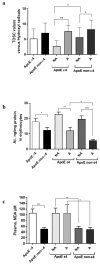Impact of ApoE Polymorphism and Physical Activity on Plasma Antioxidant Capability and Erythrocyte Membranes
- PMID: 31717561
- PMCID: PMC6912376
- DOI: 10.3390/antiox8110538
Impact of ApoE Polymorphism and Physical Activity on Plasma Antioxidant Capability and Erythrocyte Membranes
Abstract
The allele epsilon 4 (ε4) of apolipoprotein E (ApoE) is the strongest genetic risk factor for Alzheimer's disease (AD). ApoE protein plays a pivotal role in the synthesis and metabolism of amyloid beta (Aβ), the major component of the extracellular plaques that constitute AD pathological hallmarks. Regular exercise is an important preventive/therapeutic tool in aging and AD. Nevertheless, the impact of physical exercise on the well-being of erythrocytes, a good model of oxidative stress and neurodegenerative processes, remains to be investigated, particularly depending on ApoE polymorphism. Herein, we evaluate the oxidative status, Aβ levels, and the membrane's composition of erythrocytes in a cohort of human subjects. In our hands, the plasma antioxidant capability (AOC), erythrocytes membrane fluidity, and the amount of phosphatidylcholine (PC) were demonstrated to be significantly decreased in the ApoE ε4 genotype and non-active subjects. In contrast, erythrocyte Aβ content and lipid peroxidation increased in ε4 carriers. Regular physical exercise was associated with an increased plasma AOC and membrane fluidity, as well as to a reduced amount of erythrocytes Aβ. Altogether, these data highlight the influence of the ApoE genotype on erythrocytes' well-being and confirm the positive impact of regular physical exercise.
Keywords: ApoE ε4; amyloid beta; cellular membrane; erythrocytes; oxidative stress; physical activity.
Conflict of interest statement
The authors declare no conflict of interest.
Figures





References
Grants and funding
LinkOut - more resources
Full Text Sources
Miscellaneous

